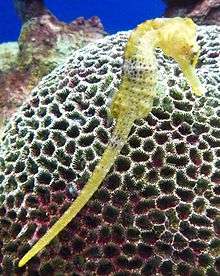Long-snouted seahorse
Hippocampus guttulatus, commonly known as the long-snouted seahorse and in Great Britain as the spiny seahorse[3], is a marine fish belonging to the family Syngnathidae, native from the northeast Atlantic, including the Mediterranean.
| Long-snouted seahorse | |
|---|---|
 | |
| Scientific classification | |
| Kingdom: | Animalia |
| Phylum: | Chordata |
| Class: | Actinopterygii |
| Order: | Syngnathiformes |
| Family: | Syngnathidae |
| Genus: | Hippocampus |
| Species: | H. guttulatus |
| Binomial name | |
| Hippocampus guttulatus (G. Cuvier, 1829) | |
| Synonyms[2] | |
Description
The long-snouted seahorse is a small-sized fish that can reach a maximum length of 21.5 cm but the average size is more or less 12 cm.[4][5] The body is slender, the snout is long and the tail is prehensile. Its head and dorsal ridge have often some more or less long and numerous dermal filaments which can be simple or bifid. Its color ranges from dark green to different variants of brown to yellow, the body is often speckled with small white dots.[6]
Distribution and habitat
The long-snouted seahorse is widespread throughout the temperate waters of the eastern Atlantic Ocean from the south coast of the United Kingdom to the Netherlands and south to Morocco, including the Canary Islands, the Azores and Madeira and the Mediterranean Sea.[5][7][8][9]
This seahorse likes shallow coastal waters from 1 to 20 m deep.[10] It occurs close by Posidonia and eelgrass meadows or in mixed habitat with sandy bottom and rocks with algae.[5][11][10]
Biology
The long-snouted seahorse has a carnivorous diet and feeds on small crustaceans, larvae, fish eggs and other planktonic organisms.[5] It is ovoviviparous and it is the male who broods the eggs in its ventral brood pouch. The latter includes villi rich in capillaries that surround each fertilized egg creating a sort of placenta supplying the embryos. When fully grown, pups will be expelled from the pocket and evolve in complete autonomy.
Conservation status
The long-snouted seahorse is relatively rare and limited data exist on its population and about the volume and the impact of trade for the traditional Chinese medicine and for the aquarium, thus the species is considered as "Data Deficient" on the IUCN Red List.[9][1] Internationally, it is also listed in Appendix II of the Convention on International Trade in Endangered Species of Wild Fauna and Flora (CITES) this means that it is on the list of species not necessarily threatened with extinction, but in which trade must be controlled in order to avoid utilization incompatible with their survival.[1][12]
References
- Pollom, R. (2017). "Hippocampus guttulatus". The IUCN Red List of Threatened Species. 2017: e.T41006A67617766. doi:10.2305/IUCN.UK.2017-3.RLTS.T41006A67617766.en.
- Froese, Rainer and Pauly, Daniel, eds. (2018). "Hippocampus guttulatus" in FishBase. February 2018 version.
- "Seahorse Facts". The Seahorse Trust.
- Curtis, J.M.R. and A.C.J. Vincent, 2006. Life history of an unusual marine fish: survival, growth and movement patterns of Hippocampus guttulatus Cuvier 1829. J. Fish Biol. 68:707-733.
- Ader, Denis; Barrabes, Michel; Huet, Sylvie (2014). "Hippocampus guttulatus Cuvier, 1829" (in French). DORIS.
- "Hippocampus guttulatus Hippocampe moucheté" (in French). cotebleue. Retrieved 19 May 2018.
- Dawson, C.E., 1990. Syngnathidae. p. 658-664. In J.C. Quero, J.C. Hureau, C. Karrer, A. Post and L. Saldanha (eds.) Check-list of the fishes of the eastern tropical Atlantic (CLOFETA). JNICT, Lisbon; SEI, Paris; and UNESCO, Paris. Vol. 2.
- Lourie, S.A., S.J. Foster, E.W.T. Cooper and A.C.J. Vincent, 2004. A guide to the identification of seahorses. Project Seahorse and TRAFFIC North America. Washington D.C. (University of British Columbia and World Wildlife Fund): 114 p.
- Woodall, L. 2012. Hippocampus guttulatus. The IUCN Red List of Threatened Species 2012: e.T41006A16997706. doi:10.2305/IUCN.UK.2012.RLTS.T41006A16997706.en. Downloaded on 21 October 2015.
- Foster, S.J. and A.C.J. Vincent, 2004. Life history and ecology of seahorses: implications for conservation and management. J. Fish Biol. 65:1-61.
- Lelong, P., 1995. Hippocampe moucheté, Hippocampus ramolosus. Océanorama (Institut Océanographique Paul Ricard) No. 24, June 1995, p. 19-20.
- "Long-snouted Seahorse". CITES. Retrieved 19 May 2018.
